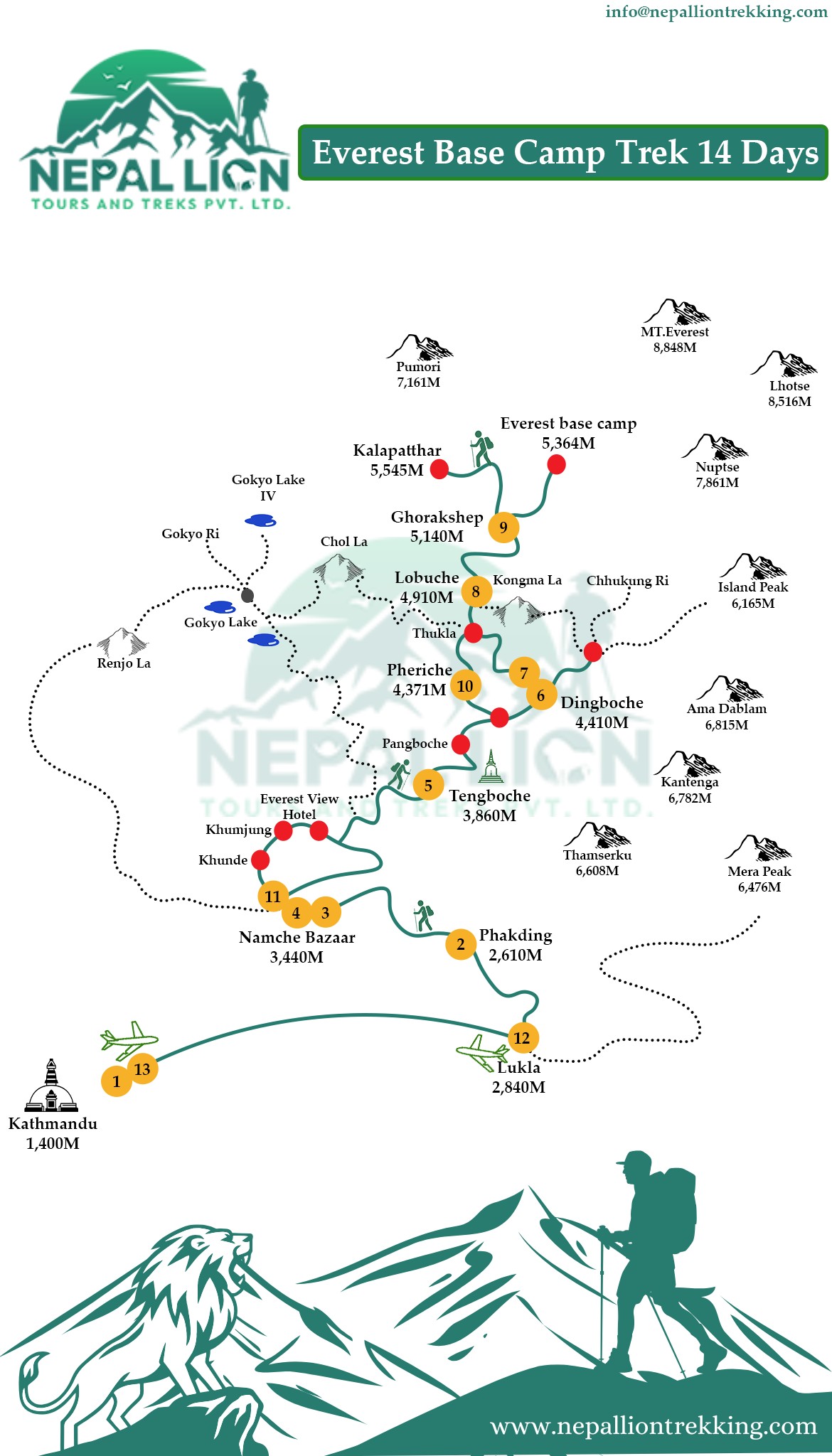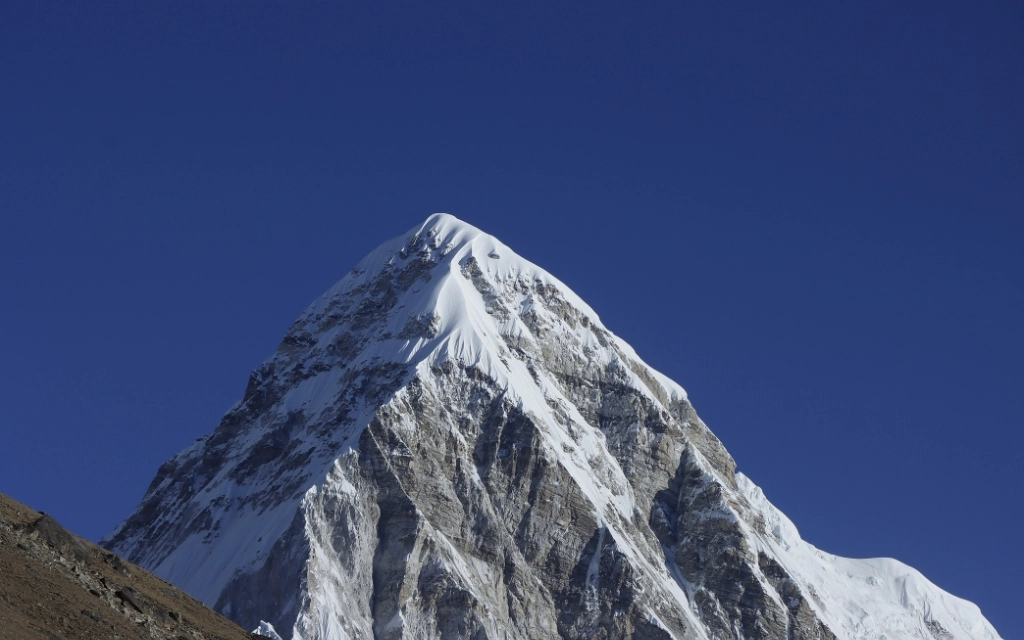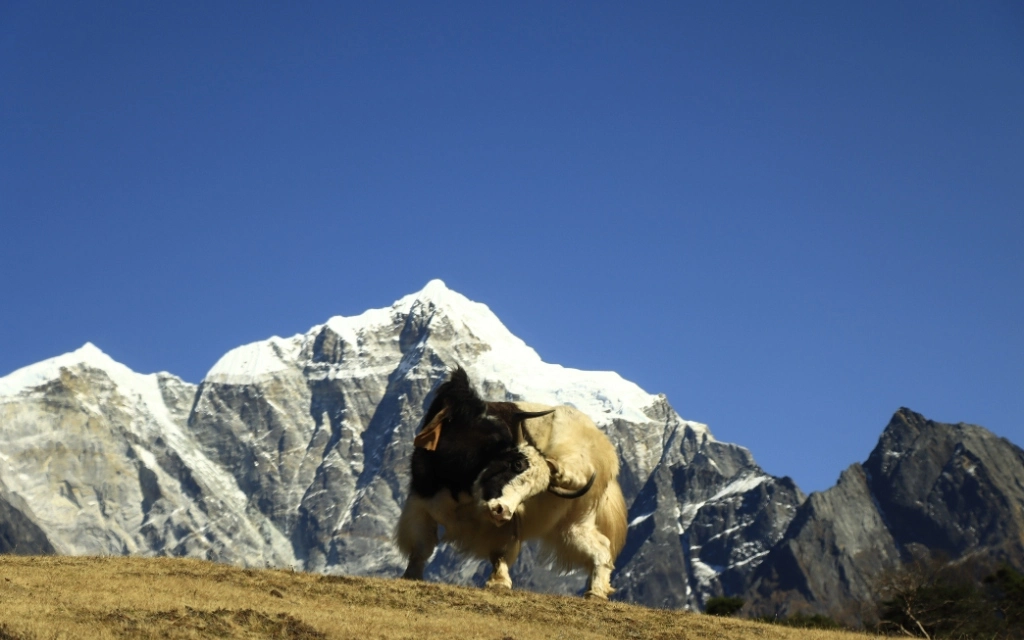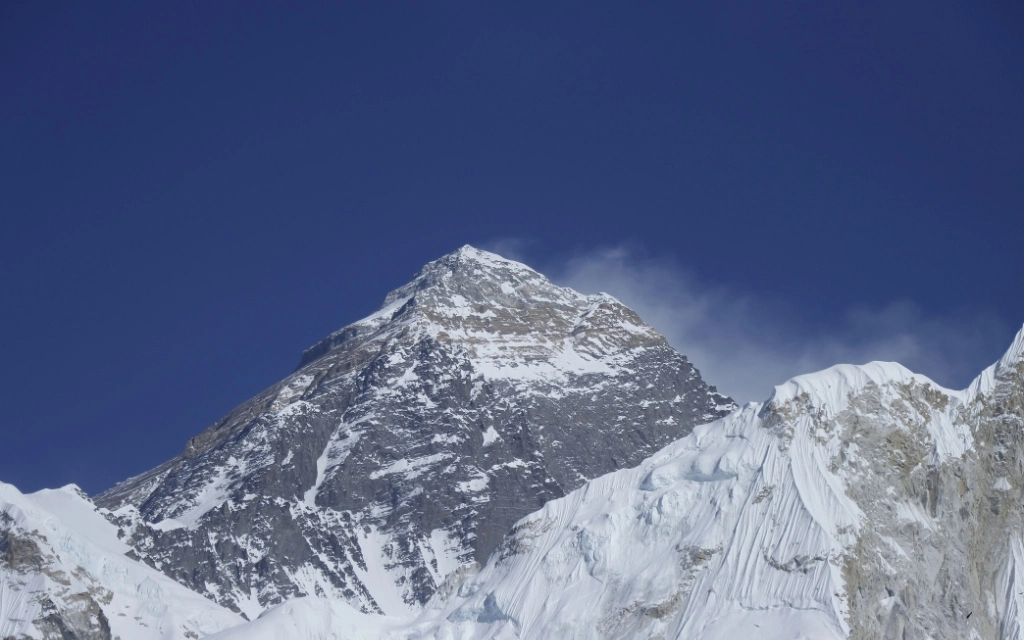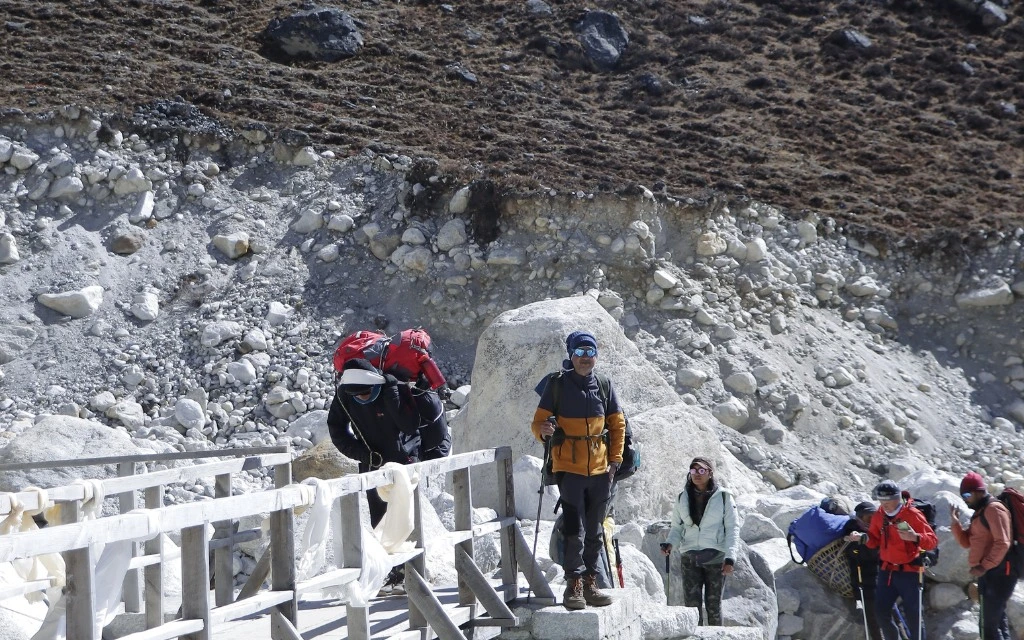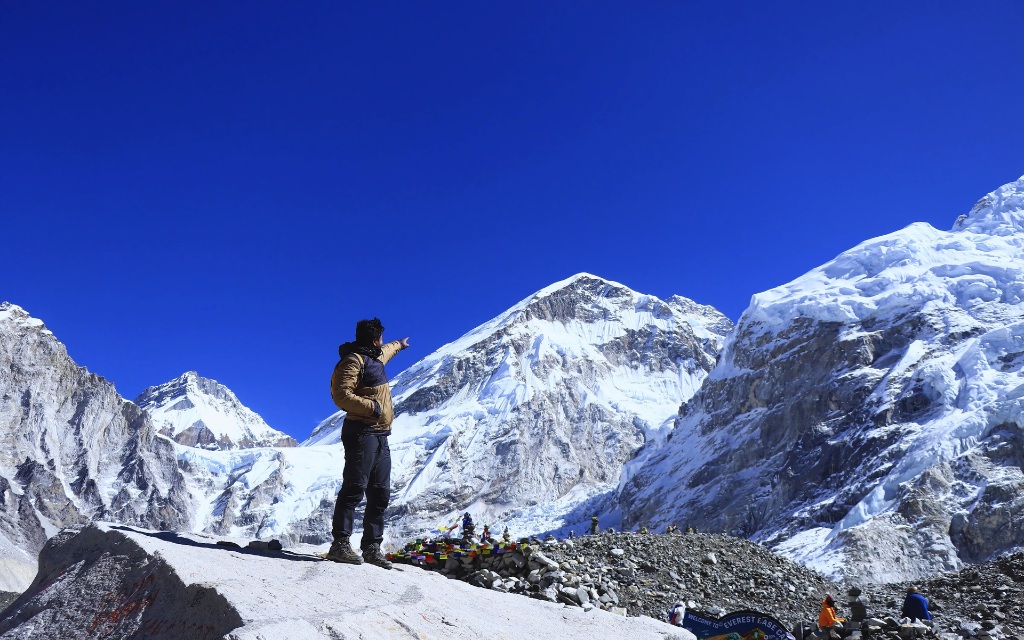
Everest Base Camp Trek 14 Days
Tour Gallery
Overview
The Everest Base Camp trek, often referred to as EBC trek, is a mesmerizing journey that takes you to the foot of the tallest mountain on Earth. Nestled in the heart of the Khumbu region in Nepal, this trek is a testament to human endurance and the breathtaking beauty of the Himalayas.
Mount Everest, the highest mountain in the world, and everyone wants to conquer it. The 14-day EBC trek is among the most fascinating ones. Trekkers step into colorful Kathmandu with culture shock before flying to Lukla, which serves as the entry point to the mountain. This implies that every day on the trail is a combination of a physical test and an exploration of the cultural value systems of the people occupying the trail. Covering everything from tropical rainforests and suspension bridges to snowy paths to the base of the highest mountain of the world every single step is a sight for sore eyes as well as learning about Sherpa people and their life. All these includes itineraries, permits for the trekkers to get through, accommodation, meals, guide services are well provided for thus the trekkers enjoy their time out.
The not to miss attractions of the trek include Namche Bazaar, Tengboche Monastery and the Everest Base Camp. The correct acclimatization process is incorporated into the schedule since the trekking programs' main goal is the opportunity to slowly ascend to that height and enjoy the travel without any health issues. This ranges from viewing sunrise at Kala Patthar over Mount Everest to actions and chit-chat with a Sherpa all count for the journey's impact. This trek is more than going to the place; it is a process, the people which you cross the way, the time which you spend and the moments which you will never forget.
Everest Base Camp Trek Cost
When it comes to the topic of planning for a trek, one of the first things that any trekker will care about is the expenses carried out. The cost of trek to the Everest Base Camp depends, as little as $1,200, but as much as $5,000. One has to be very careful to look for a package that will be economic while at the same time will offer a safe ride as well as fun. These expenses usually include fees such as permits, accommodation, meals during the trip and hiring of tour guides. The luxury level packages provide more comfort or equipment, and services or better accommodation and equipment, and the level offers some compromise and takes a bit of work. Finally, securing that which can be afforded comfortably in a shared resource combination and that which is helpful for the venture is typical.
Choosing the Right Package
Selecting the right package for your Everest Base Camp trek is very vital so that you will enjoy your trek fully. They may combine food and drink, accommodation, permits, and a professional guide who can show you around as you get used to the terrain. Therefore, it is necessary to make research on what company to hire in order that the whole process would be appropriate. A good starting point is to read reviews, ratings, and testimonials published by other trekkers who worked with a given company before. More than anything else, laying emphasis on the orderly and safer trek will add on to the overall satisfaction and memory of the trekker while on the journey through the demanding Everest Base Camp.
The Everest Base Camp Trek Itinerary
A correct schedule is highly recommended in order to make the most out of this amazing trek and avoid altitude sickness issues. The 14-day trek commences with arrival at Kathmandu and subsequent days of rest and familiarisation with the Sherpa country before joining the flight to Lukla, the gateway to the Mount Everest Region. During this, trekkers get opportune to trail village settlements like Phakding and Namche Bazaar, moving through forests and crossing steel suspension bridges over the Dudh Koshi River. These hikes direct experience of amazing views coupled with physically distressing climbs of steep hills with a weight in rucksack to offer; admiration of close ranges of the world famous Tengboche Monastery and adorable cultural villages of Dingboche and Lobuche form the highlights of each day's hikes.
Gradually when you move ahead, the geography changes to high altitude views of the majestic Himalayas. This has vital acclimatization days as in Namche Bazaar and Dingboche which gives your body a chance of adapting to the altitude. Taking a thrilling climb followed by meeting the locals, visiting the incredible Buddhist monastery, summiting the base camp, witnessing the awe-inspiring sunrise on the snowy mountain peak of Kala Patthar. The way back, retracing the steps to Lukla, provides ample time for contemplation of the mind-blowing experience. Every day is a mix of exercising and discovery of the local traditions and languages – something one cannot get anywhere other than in the middle of the Himalayas.
Understanding Altitude: Everest Base Camp Height and Altitude
Weather conditions are quite an important aspect to be contemplated when on a trek at the EBC journey. Located at a staggering 5,364 metres (17,598 feet) the base camp is at an altitude that should cause worry on the onset of altitude sickness. For the human body, there is a process of acclimatisation by which the body gradually gets used to the up and coming circumstances of high altitudes which is characterised by lower levels of oxygen in your blood.
In an effort to minimize altitude sickness, it is most advised to spend at least a couple of days resting under challenging altitudes like Namche Bazaar and Dingboche. These stops help your body acclimate to the thinning air and, thus, make the trip as safe and fun as it can be. By the time that a person arrives, they should already be used to the altitude which enables a clear vision and proper appreciation of the beautiful scenery as well as the achievement.
Mapping Your Everest Adventure
Planning out your trek to Everest is essential in organizing the whole trip. A detailed map is your reliable friend, which will always keep you from getting lost anywhere whether; it is a dense forest, rough roads or icy glaze. A good map helps you know the direction to take or even have a glimpse of the geography of the surrounding areas. It's not merely an exercise that allows the wrong way finding, it brings a sense of the location, of the place, of the regions one is navigating through – the Himalayas.
As for safety many trekkers also take along with them their GPS devices for extra protection and accuracy. These devices can be handy when you are in a confusing trail and you want to be confident you are going in the right direction. Both will only require a map and compass or the GPS system to guide you through the whole trip and be ready for a fantastic experience.
Nepal Everest: Beyond The Trek
The EBC trek is far more than just a physically adventurous expedition; tourists will be able to engage in Nepal's vibrant culture. During the walk, you can also have an excellent chance to familiarize with the traditions of the local Sherpa people. This is made possible by the exploration of the movement through ancient monasteries where one might be privileged to see ages old rituals and practices. In the process you also have the opportunity to enjoy the Nepali local foods and get to taste the Nepali cuisines. These cultural encounters give so much more meaning to the adventure and extraordinary beauty of trekking that it itself becomes much more than just the gorgeous scenery.
My Everest Trip: Personal Reflections
The journey to EBC was indeed life-changing. The trek was exhausting and challenging in all ways possible, but everything that felt like pushing a button was accompanied by what has to be one of the most beautiful sights in the world – the Himalayas. Whether walking through the thick of tall trees and fording streams or hiking over sharp rocks and pausing in front of icy glaciers, everything was awe-inspiring. The destination wasn't limited to getting to the Base Camp; it was about all the fun with other trekking buddies and the hospitality of the Sherpas. I will forever cherish the view of the first rays of sun winking over the great peaks of the world through the vantage point of Kala Patthar. This was a journey and it will not be wrong to term it an adventurous one because firstly I will remember it and secondly it is memorable.
Everest Trekking in Nepal: A Growing Trend
The adventure of trekking in the mighty Everest region of Nepal has also tremendously increased year after year. The desire to get to the base of the highest mountain in the world pulls in travelers from all over the globe. This trek is definitely one of the kind because of the challenge that the Himalayas present and the beauty that is found in them. With each year seeing more and more trekkers take up this challenge, the Nepalese government has followed suit in trying to ensure responsible tourism. Both of their projects' objectives are to protect the natural and cultural resources in the area, so that the future generations can also be able to appreciate such magnificent sceneries.
For these endeavors, there has been put in place that would reduce the impacts on the environment and on the communities. These are preserving the standard state of the trekking trails, endorsing responsible use and visitation, and guaranteeing that the coming of increasing volume of tourists is not detrimental to the environment while positively impacting the external economy of the area. By such approaches the ever famous Everest trekking maintains the life fulfilling experience together with the environment and culture of the region.
Trip Highlights
- ☞Thrilling scenic flight from Kathmandu to Lukla.
- ☞Exploration of Sherpa villages like Namche Bazaar and Tengboche.
- ☞Acclimatization with panoramic Everest views from Everest View Hotel.
- ☞Trekking through Sagarmatha National Park (UNESCO World Heritage Site).
- ☞Visit to Tengboche Monastery with stunning mountain vistas.
- ☞Sunrise views of Everest and peaks from Kalapatthar (5,545 m).
- ☞Reaching Everest Base Camp (5,364 m), a mountaineering milestone.
- ☞Diverse landscapes: alpine forests, rivers, and high-altitude terrain.
- ☞Authentic teahouse trekking experience and local meals.
- ☞Insights into Tibetan Buddhist culture with monasteries and prayer flags.
What's Included
Included Services
- ✓Pick-up or Drop-off service from and to Airport (in our own vehicle)
- ✓3 star hotel in Kathmandu with breakfast
- ✓Transportation from Kathmandu to Lukla and back to Kathmandu (by flight)
- ✓Food all along the trip(Breakfast, Lunch, Dinner and a cup of coffee or tea) and accommodations during the trip in hotels with family environment
- ✓One licensed English or Chinese or Korean or Hindi along with Nepali speaking trekking guide
- ✓Transportation, food, accommodation and insurance of Guide during the trip
- ✓Down jacket, all-season sleeping bag, duffel bag and trekking map(in case if you don't have your own. Down jacket, sleeping bag and duffel bag must be returned after completion of the trip)
- ✓First Aid Medical Kit(Carried by the guide)
- ✓All the required permits and paperworks
- ✓2 Nights hotel free
Excluded Services
- ✗International Airfare
- ✗Visa Charges
- ✗Your travel and medical insurance
- ✗Personal Expenses such as shopping, bar bills, hot shower, telephone, laundry, titbits etc
- ✗Services not mentioned or not promised by the Agent / Agency
- ✗Emergency expenses such as expenses on charted Flights / Helicopter
Detailed Itinerary
More Information
How hard is the hike to Everest Base Camp?
Trek to the EBC is tiring; however, it is quite an adventure, which is why people love travelling in the first place. There are up and down slopes, sharp rock edges and sometimes high altitude that can cause much stress to one's muscles and joints. The way it is designed, the thicker you climb up, the thinner the place becomes and as a result, it is harder to progress on the next step. It is also important to note that adjustment to these conditions in order to avert altitude sickness is a grievance in acclimatization. Physical health is also important, good health shall enable you to complete the most intensive portions of the trekking.
However, all those difficulties in my opinion, with proper approach and readiness reaching the base of Mount Everest is one of the most rewarding ever undertaken. The journey is challenging in the extreme yet, along the way there is dramatic scenery and the sense of achievement at the end is immense. That is what this movie is about, perseverance and the human spirit.
How long does an Everest Base Camp trek take?
The Everest Base Camp trek typically takes around 12 to 14 days, depending on the specific itinerary, acclimatization needs, and individual trekking pace. This timeline allows trekkers to ascend gradually, ensuring they can adapt to the high-altitude conditions. Proper acclimatization is crucial to prevent altitude sickness and make the journey safer and more enjoyable. The trek starts from the bustling city of Kathmandu, leading through picturesque villages like Namche Bazaar and Tengboche, and offers stunning views of the Himalayan landscape along the way.
Allowing sufficient time for the trek not only helps in adjusting to the altitude but also provides opportunities to immerse in the local culture and scenery fully. Each day is a balance of challenging hikes and moments of awe, as you witness the grandeur of the mountains and the resilience of the Sherpa people. Whether you're a seasoned trekker or a first-timer, planning for a 12 to 14-day journey ensures you can savor every step of this iconic adventure and create memories that last a lifetime.
Can a beginner trek Everest Base Camp?
Still the level of difficulty can be considered as moderate and in any case Everest Base Camp trek is easy to accomplish by a beginner with average physical fitness and perseverance. What this means is that you must be physically fit for the hike, and this includes typically rigorous workouts that strengthen muscles accustomed to the hikes as well as aerobics. When a person starts a fitness regimen several months before the event, the results are just enormous. In the same respect, it is also essential that people take time to get acclimatised adequately from the chimelab to the actual thing itself. Staying a day or two extra in points such Namche Bazaar and Dingboche to acclimatise and conquer altitude sickness make the trek doable.
Selecting an excellent and tight plan with professional guides also helps when it comes to the experience as well. Tourist guides may be of great help, can motivate you, give pieces of advice regarding the customs and climate of the area. They guide you as to when you need to be where, assist in managing altitudes and most importantly, turn your trip into a safer and fun experience. Every beginner receiving proper preparation and encouragement for the trek can undertake the Everest Base Camp successfully and enjoy the tour.
Can I climb Everest with no experience?
It is strongly advised that anyone embark on a Mount Everest expedition after receiving prior training. The summit puts strenuous tests to climbing skills and physical tenure and only qualified mountaineers with high altitude experience deserve to attempt the dangerous terrain. Trying this challenge with this crucial meaning can be safe to your life and lives of the other climbers. These training not only contribute to enhancing the possibility of the successful summiting but also allow checking the learners' ability to face severe conditions together with probable necessary evacuation. Therefore, there is a need to gain familiarity with other earlier mountains that have relatively low elevation compared to Everest.
Can you do Everest Base Camp without training?
Training or certification is optional for the 14-day EBC trek; it is imperative for the physically fit participants to be prepared. The trek trials involve normally impassable rugged terrains that are at sometimes high altitudes and this is physically demanding. Cardiovascular exercises, weight training exercises, and acquaintance with the climate marches are considered mandatory. These preparations help prepare you physically and psychologically to help build your endurance and drastically minimize any problems resulting from the altitude to enjoy the fantastic view that comes with the experience. It is all about preparing yourself both physically and psychologically to face challenges on the trek and be ready and able to enjoy every moment of the trek fully.
How many km is Everest Base Camp Trek?
Mount Everest base camp is approximately 130 kilometers (80 miles) in its round trip distance. The distance can depend on the selected route and if the trip includes a detour. On average, this distance takes trekkers between 12 and 14 days; however, it depends on the itinerary of the trekking period and the acclimatization periods. This is not only the survival test but one of the most thrilling adventures of a lifetime from the perspective of mountains. On this trek, you are able to cross through forests, glacial rivers, and mountains , which is even more exciting.
Who is eligible for the Everest Base Camp Trek?
The EBC trek is open to 'fit and healthy' persons and therefore when considering the social element all persons in good fitness and health can perform this trek. First of all it should be noted that despite the fact that prior trekking experience is valued, those who still need it but prepare well can handle the task. Due to the high altitude of the trek, special attention must be paid to acclimatization in order to avoid getting sick. Before the trek is carried out, it is advisable to schedule cardio and strength training activities for several months before the trek. Also, trekkers should check with their doctor to find out whether or not they are suitable for the trek due the state of their health. While many may consider this route, making the dream a reality requires forethought and determination to go through the adversities.
How do I prepare for base camp?
As to the physical conditioning, it should be mentioned that preparation for the Everest Base Camp does not concern only an individual's physical shape. First of all, working on cardiovascular health using such exercises like running, cycling or swimming will help to develop proper stamina for hiking at height. Include weight-lifting movements that would enhance muscle and energy, leg workouts, abdominal workouts, and workouts that cover the upper part of your body. Also, work with weight in your back bag to mimic the conditions involved in trekking. So, ideas for training at high altitudes are necessary, otherwise it becomes necessary to make use of acclimatization tools so as to enable the body to adapt to the low oxygen availability.
To this end, it is necessary to invest in the right kind of equipment, same as any other component of effective production. It would help if you had good quality trekking boots, quick-dry clothing, good quality sleeping bag, among other accessories including trekking poles, backpacks etc. Take the time to learn about the gears when you're learning to control them, this way they can be used to test comfort levels. It is also suitable for the mind—always train your mind to be prepared for the challenge ahead and be willing to make the task a long-term project, noting that this is a long journey, which requires a lot of physical effort, but is well worth it. It is advisable to consult a health care practitioner before undertaking the trek as regards your health fitness level. When you have the preparation and the mindset, you're ready to go on this incredible journey.
Trek Map
